Chinese characters speak
Updated: 2015-02-06 11:28
By Liu Chang in Arlington, Virginia(China Daily USA)
|
|||||||||
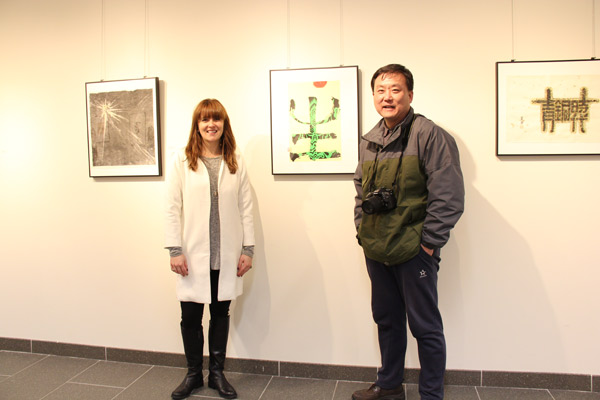 |
|
Maggie Edwards (left), administrative coordinator of arts management at the College of Visual & Performing Arts at George Mason University, and Zhai Dongwei, a visiting scholar from Henan University, with Zhai's artwork called Sheng.The display is part of an exhibit titled Characters, Language and Design. [Photo by Liu Chang /China Daily] |
An art exhibit is using Chinese language characters not only for their beauty but to promote cultural communication and understanding.
The Confucius Institute at George Mason University (GMU) and the School of Arts at the Beijing Language and Culture University opened an exhibition Wednesday at the Founders Hall Gallery on the GMU campus.
Maggie Edwards, coordinator of arts management at GMU's College of Visual & Performing Arts (CVPA), said the display is part of a project called Characters, Language and Design.
Thirteen art works created by university students and faculty members will be shown until March 8.
"We put a call out to artists before they went on the break for holiday last December," Edwards said. "After they submitted their works, we selected works for display based on their art design and philosophical implications."
The theme requires using Chinese characters in design elements. Each artist decides which Chinese characters to use.
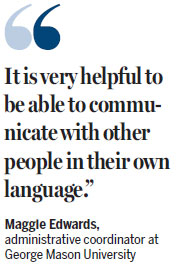
Edwards said it beneficial to get artists thinking about the world's languages.
"It promotes understanding of different languages and cultures," she said. "It can make a heightened appreciation for them. For some people, it makes something they are used to seeing daily more beautiful and interesting.
"It is very helpful to be able to communicate with other people in their own language," Edwards said. "You are brought closer, and understand more where they are coming from. Chinese characters are well designed and purposeful. People take time and care to design them. So they lent them very well to art."
The Confucius Institute began a conversation with the CVPA last winter before they agreed to put on the exhibition.
Qing Gao, managing director of the Confucius Institute at GMU, said that by hosting such an exhibition, visitors' perceptions of Chinese characters might change. He explained that many people consider Chinese characters difficult to learn.
"We want to create a new way of thinking about Chinese characters," Gao said. "They are the crystallizations of 5,000 years of wisdom. In contrast to their difficult and dull image, they are full of lively and artistic imagination."
Zhai Dongwei, a visiting scholar from Henan University, had his work Sheng displayed. Sheng literally means born. Zhai said sheng has many meanings, such as reproduction, moving upward and profundity.
"Philosophically speaking, everything includes two opposite sides," Zhai said. "So I put this controversial conception into my works, through using design pattern and colors."
Zhai said that every nation and ethnicity has something to be proud of.
"For a culture like China's, we should think more about whether we want to be understood by others than about how long our history is boasted of," he said.
Lili Ren, a Chinese teacher at the campus Confucius Institute, said there is no boundary for art.
"People of different languages can understand it," Ren said. "The exchange of arts boils down to the exchange of peoples, who are interested in understanding an exotic culture and society.
"Few people can speak Chinese fluently," she said. "But those who study it are showing an interest and appreciation in Chinese culture. Ni hao (how are you?) can be said by many foreigners in the world. But behind this greeting, they will give back in various forms as they later become individual ambassadors for the two countries."
changliu@chinadailyusa.com

 Across America over the week (from Jan 29 to Feb 5)
Across America over the week (from Jan 29 to Feb 5)
 Bringing Hollywood into your home
Bringing Hollywood into your home
 Snow turns village in Xinjiang into a fairy world
Snow turns village in Xinjiang into a fairy world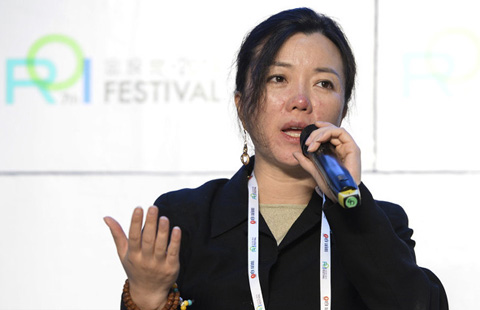
 Global firms that changed top execs after China biz hurdle
Global firms that changed top execs after China biz hurdle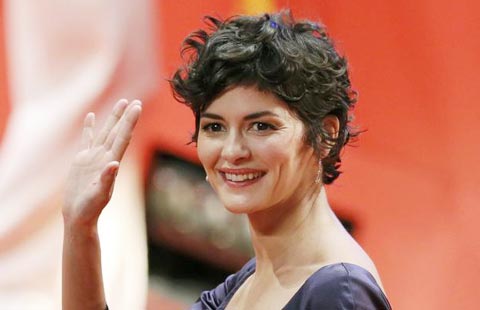
 65th Berlinale International Film Festival opens
65th Berlinale International Film Festival opens
 Young TV producer crowned Queen of Amazon tribe
Young TV producer crowned Queen of Amazon tribe
 Family members mourn air crash victims
Family members mourn air crash victims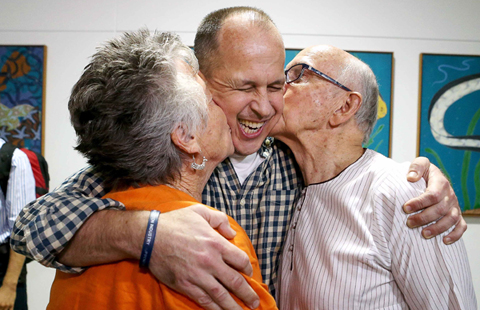
 Australian journalist Peter Greste arrives home
Australian journalist Peter Greste arrives home
Most Viewed
Editor's Picks

|

|

|

|

|

|
Today's Top News
Chinese Americans growing as spenders
Tax, tech rules 'test' US-China relations
Train-makers set for sales boost abroad
China's view of social media dims: report
Yum and McDonald's profits drop after supplier scandal
Australia lawmakers set to vote on PM Abbott's future
4 children killed in Texas house fire
Canadian detained on suspicion of stealing state secrets
US Weekly

|

|








